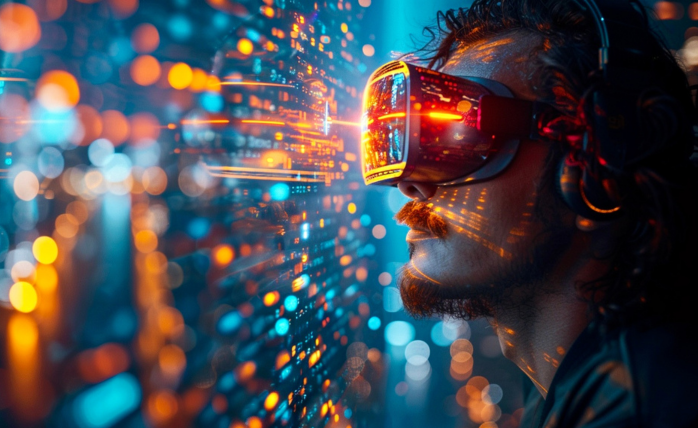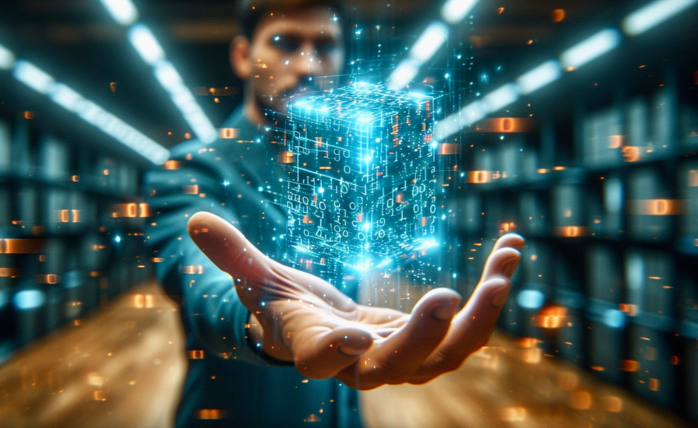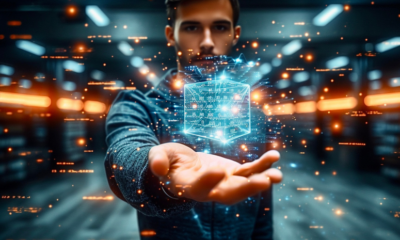Tech + Humanity Integration
10 Ways to Use AI to Enhance Your Ecommerce Marketing Strategy
Artificial intelligence will help you better serve your customers

Have you ever messaged a website’s chatbot to ask for help? Bought something from an online shop recommended items section? Or wondered why Taylor Swift concert ticket prices are exploding on Ticketmaster? Then you’ve seen how companies leverage artificial intelligence or AI to do some of their work.
Dynamic pricing, product recommendations, and chatbots are just some of the most common examples of AI tools businesses use today. Imagine if you had to do all those tasks by hand; you’d be drowning in the nitty-gritty details of your business instead of planning for the future and thinking of ways to expand.
If you would rather spend more time working on your business than working in your business, then you’ll want to consider taking advantage of AI. Here’s a look at how you can use AI to enhance and streamline your ecommerce marketing strategy.
Why Use AI in Your Ecommerce Business?
Like any business, ecommerce still involves many processes that need attention to detail and time to accomplish. With AI, you don’t have to do everything yourself.
AI doesn’t sleep, and it doesn’t get distracted. Errors are also less likely to occur when you use artificial intelligence. That’s not to say we can do away without the human touch; think of AI as round-the-clock assistants that help you and your team save time, make data-driven decisions with ease, and optimize your marketing efforts.
Another big part of an online business’ success lies in giving customers what they want when they want it. Savvy entrepreneurs can deliver this through AI. By providing personalized experiences, companies can attract prospects that are more likely to convert and stick around for the long run.
How to Use AI for Your Ecommerce Marketing Strategy
Here are a few ways that you can use AI for your ecommerce business:
1. Personalized Product Recommendations
A survey by Insider Intelligence shows that 73% of consumers expect companies to understand their unique needs and expectations. Fifty-six percent of those surveyed say they expect offers always to be personalized.
With AI, you can enhance your ecommerce marketing strategy by offering personalized product recommendations. AI algorithms can deliver tailored recommendations to each individual, increasing the chances of conversion. It does this by analyzing behavior on your website, purchase history, and preferences.
Using AI-powered recommendation engines can improve customer engagement and, ultimately, boost sales.
2. Chatbots for Customer Support
The virtual doors to ecommerce stores are always open. If you snooze, you could lose out on potential sales. Chatbots can handle multiple conversations simultaneously, ensuring 24/7 customer service.
These virtual assistants can understand customer queries, provide instant responses, and even resolve common issues. Digital consumers today expect companies to respond to inquiries rapidly.
By incorporating chatbots into your ecommerce website or messaging platforms, you can improve response times, enhance customer satisfaction, and reduce support costs.
3. Automated Email Marketing Campaigns
Email marketing is still one of the top ways to get prospects to convert. And with email marketing, quality matters over quantity.
With AI’s machine learning algorithms, it can segment customers based on behavior, interests, and preferences. This allows for the delivery of highly targeted and personalized email content that resonates with the recipient, increasing open and click-through rates, and driving conversions.
You can also use AI to automate and optimize email marketing campaigns, improving their effectiveness and saving you time.
4. Visual Search for Improved Product Discovery
Visual search is an exciting AI technology that enables customers to search for products using images rather than text. By integrating a visual search feature into your ecommerce platform, you can provide a seamless and intuitive search experience.
Customers can simply upload or take a picture of a desired product, and AI algorithms will match it with visually similar items in your inventory. This improves product discovery and enhances the shopping experience.
5. Predictive Analytics for Demand Forecasting
With AI, you don’t need a whole team of analysts to predict demand. You can say goodbye to stockouts and keep your customers happy by ensuring your most popular products are always in stock.
AI algorithms can analyze vast amounts of historical data to forecast future demand patterns accurately. It uses predictive analytics to help ecommerce businesses optimize inventory management, prevent stockouts, and avoid overstocking.
This data-driven approach helps businesses maximize revenue by aligning inventory with anticipated demand.
It’s a win-win for both sides: it maintains customer satisfaction while reducing your inventory costs and loss of sales.
6. Dynamic Pricing Optimization
AI-powered dynamic pricing algorithms aren’t new. The tourism industry is one of the earliest adopters of dynamic pricing, used by hotels and airlines to offer customers different prices based on various factors.
The ecommerce industry is slowly waking up to the use of dynamic pricing, with Amazon being an example. AI-based dynamic pricing helps ecommerce businesses optimize their pricing strategies in real-time. These algorithms analyze various factors, such as competitor prices, demand levels, and customer behavior, to determine the optimal price for each product at any given time.
Dynamic pricing can help maximize your revenue and capitalize on fluctuations based on market demand.
Some online businesses may hesitate to try dynamic pricing because they feel it might hurt their brand and user experience. To make sure it doesn’t, you can set price limits that reflect your value while still giving you the flexibility to earn more profit.
Another way to try our dynamic pricing is to use it for seasonal and limited-edition offers.
7. Customer Segmentation
A good marketer knows that if you’re selling to everyone, you’re selling to no one. Segmenting your customer base is the first step toward offering personalized and targeted experiences that resonate with each customer.
AI can assist in identifying customer segments by analyzing data points such as demographics, purchase history, browsing behavior, and preferences. This helps you create highly personalized marketing campaigns tailored to each segment’s specific needs and interests.
Segmenting your customer list increases the relevancy of your marketing messages. With personalized offers, you can easily catch the attention of your target customer and drive conversion rates.
8. Sentiment Analysis for Customer Insights
Understanding customer sentiment (how customers think and feel about your brand) is crucial for effective ecommerce marketing. If you want to stay in touch with your target market’s needs and wants, using AI to gauge sentiment analysis is one way to keep your finger on the pulse.
In the past, companies used surveys like the customer satisfaction (CSAT) score or Net Promoter Score® (NPS) and focus group discussions to get data. Today, AI-powered sentiment analysis tools can comb through information like customer feedback, reviews, and social media posts to gauge sentiment and identify trends.
This valuable data can provide insights into customer preferences, satisfaction levels, and pain points. It helps brands know how people feel about their products and services, allowing companies to respond quickly or react in case of problems.
9. Split Testing Ad Copy
Using AI for split-testing ad copy can enhance your advertising campaign’s effectiveness by helping you identify which ad variations resonate better with your target audience. Here’s a look at how to utilize AI for split-testing ad copy:
- Collect Data and Define Goals: Start by collecting relevant data about your current ad campaign’s performance and determine your campaign’s goals.
- Generate Ad Variations: Utilize AI-powered natural language generation (NLG) tools to create multiple ad copy variations.
- Create Testing Groups: Divide your target audience into testing groups and use AI to randomize the ads for the testing groups.
- Tracking and Analytics: AI will help you make sure you have proper tracking mechanisms in place to monitor the performance of each ad variation.
- Data Collection: Allow the AI-powered platform to collect data over a predefined period to capture a sample size.
- Performance Analysis: Use AI to help you analyze the performance of each ad variation. Look for key metrics such as CTR, conversion rates, engagement rates, and more.
Remember that human insight is essential. AI can provide insights, but understanding your target audience and the nuances of your industry is something that often requires human intuition and expertise.
10. Generate Content
Using AI, businesses can swiftly create product descriptions, how-to guides, valuable blog content, and social media posts. By inputting key information and preferences, AI has the ability to produce engaging content that resonates with target audiences.
This accelerates content production, improves SEO, and enhances customer engagement, allowing the business to focus on growth strategies. However, it’s crucial to have an editor on hand to adjust all content produced with AI in order to maintain authenticity, brand voice, and quality.
Artificial intelligence might evoke images of science fiction robots and flying cars for some, but in reality, AI is already being used every day and is changing the ecommerce landscape.
Artificial intelligence will help you better serve your customers, which can bring about more conversions and customer loyalty in the long run. AI can also free up your precious time, allowing you to focus on what truly matters: growing your business and delighting your customers.
Boost your strategy with customer engagement
Tech + Humanity Integration
Why Personal Brands That Feel Real Are Winning in the AI Age
One’s digital persona allows them to brand themselves however they want, but the freedom to self-express digitally is no longer only about visibility

How individuals configure their online presence in today’s world reflects their self-perception and self-esteem, as the internet is filled with fragmented attention and ever-changing identities. Algorithms might determine a person’s visibility, but the things that truly capture attention run far deeper: connection, coherence, and emotional authenticity. (more…)
Entrepreneurs
9 Ways Augmented Reality Gives Your Business a Competitive Edge
By embracing AR technology, companies can unlock new opportunities for growth, innovation, and success

Leveraging Augmented Reality for Business Advancement: Exploring Applications
In the ever-evolving landscape of business innovation, Augmented Reality in business emerges as a transformative force, reshaping traditional paradigms and unlocking new opportunities for growth and advancement.
Through a comprehensive examination of AR’s capabilities, applications, and business benefits, this article serves as a roadmap for enterprises seeking to harness the full potential of augmented reality to propel their success in the digital age.
UNI.Agency as a forefront developmental agency tailors unmatched digital products and immersive experiences. They help companies outperform their competitors and customers’ expectations. And now, there is time to delve deep into the AR realm.
Gaining Insight into Augmented Reality
From revolutionizing customer experiences to optimizing operational efficiency, AR in retail is poised to drive significant advancements in how businesses operate and engage with their stakeholders.
Augmented Reality (AR) seamlessly integrates digital information and virtual objects into the real-world environment, offering users an immersive and interactive experience through devices like smartphones or AR glasses.
It revolutionizes various industries, from entertainment to healthcare, by enhancing perception and creating innovative opportunities for engagement and exploration in the digital era. AR not only enriches our understanding of reality but also opens up new possibilities for creativity, communication, and problem-solving, making it a powerful tool for businesses seeking to enhance customer experiences and streamline operations in an increasingly digital world.
Differentiating Augmented Reality and Virtual Reality
Augmented Reality (AR) overlays digital elements onto the real world, enhancing the user’s perception of their environment. Virtual Reality (VR), however, immerses users in entirely virtual environments, blocking out the real world. There are some core differences between these two technologies in gear and display approaches:
- AR enriches reality with digital information, while VR creates entirely immersive virtual experiences.
- AR typically requires less specialized hardware, like smartphones or AR glasses, while VR often involves dedicated headsets.
- AR is commonly used for enhancing real-world experiences, such as in gaming, retail, and navigation, encouraging augmented reality shopping. Whereas VR is primarily employed for immersive simulations, training, and entertainment in fully virtual environments.
The Influence of AR on the Customer Experience Journey
As of 2024, Augmented Reality (AR) has evolved into an indispensable tool across various sectors, offering immersive and interactive experiences that seamlessly blend digital elements with the real world.
Stimulating Interest
Augmented Reality (AR) captivates customers by offering visually engaging experiences that spark curiosity and intrigue, enticing them to explore products or services further.
AR’s ability to overlay digital content onto the real world creates an immersive and attention-grabbing experience, drawing customers in and igniting their interest.
Educating and Empowering Users
AR in business empowers users by providing interactive and informative experiences that educate them about products, services, or concepts in a visually compelling manner.
Through AR, customers can interact with virtual models, animations, or informational overlays, gaining a deeper understanding of the features, benefits, or use cases of the offerings.
Exploring Further Depths
AR encourages customers to delve deeper into products or services by offering immersive and interactive experiences that go beyond traditional marketing materials.
By allowing users to explore virtual representations of products in real-world contexts, AR in retail provides a unique opportunity for customers to visualize how offerings fit into their lives, fostering deeper engagement and understanding.
Business Benefits of Augmented Reality
Businesses utilize AR for diverse applications, including product visualization, virtual try-ons, and enhanced customer engagement. In education, AR transforms learning experiences by providing interactive simulations and visualizations.
Additionally, AR has become integral to industries such as healthcare, where it facilitates surgical training and patient education. With advancements in AR technology and widespread adoption, it continues to shape how we perceive and interact with our environment, ushering in a new era of innovation and connectivity.
Let’s look at why AR has become so indispensable as a business tool nowadays.
Revolutionizing Training Methods
AR in business transforms training by offering immersive, interactive simulations that replicate real-world scenarios, enhancing employee learning and skill development.
It’s lucrative for hands-on training experiences. Since there’s no need for physical equipment or environments, reducing costs and logistical constraints while improving knowledge retention and performance.
Boosting Productivity Levels
Augmented Reality in business boosts productivity by providing real-time access to information and guidance, allowing employees to complete tasks more efficiently and accurately.
Through AR-powered tools and applications, workers can streamline workflows, troubleshoot issues, and collaborate effectively, resulting in increased output and operational efficiency.
Implementing Dynamic Marketing Approaches
AR enables businesses to implement dynamic marketing strategies that captivate and engage audiences in unique ways.
By integrating AR into marketing campaigns, companies can create interactive experiences that drive brand awareness, customer engagement, and sales conversions, setting themselves apart in a crowded marketplace.
Fostering Product Development
Augmented reality and marketing foster innovation in product development by facilitating virtual prototyping, design iterations, and collaborative decision-making.
With AR, teams can visualize and test product concepts in 3D, gather feedback from stakeholders, and make informed design decisions faster, leading to faster time-to-market and more successful product launches.
Creating Tailored Customer Experiences
AR creates personalized customer experiences by allowing users to interact with products and services in customized ways.
Through AR-enhanced applications and experiences, businesses can tailor content, recommendations, and promotions to individual preferences and behaviors, enhancing customer satisfaction and loyalty.
Amplifying Brand Recognition
Augmented Reality shopping amplifies brand recognition by providing memorable and shareable experiences that leave a lasting impression on customers.
By incorporating AR into branding initiatives, companies can create immersive brand experiences that spark conversations, increase social media engagement, and strengthen brand loyalty, ultimately driving business growth and success.
Final Thoughts
In conclusion, Augmented Reality in business stands as a transformative force, offering a multitude of benefits across various aspects of operations. From revolutionizing training methods to boosting productivity levels, AR empowers businesses to thrive in an increasingly competitive environment.
By embracing AR technology, companies can unlock new opportunities for growth, innovation, and success, while delivering immersive and engaging experiences that resonate with customers and stakeholders alike.
As AR continues to evolve and integrate into everyday business practices, Uni will incorporate the best practices to promote business advancement and drive meaningful change for the clients. We’re to shape the future of commerce to your benefit.
Crypto
How Entrepreneurs Are Revolutionizing Industries With Blockchain
Blockchain technology has become a revolutionary force in the new digital age

Blockchain technology has become a revolutionary force in the new digital age with its decentralized nature, immutability, and enhanced security. It offers a vast sea of possibilities for entrepreneurs across various industries. (more…)
Tech News
Artificial Intelligence and the Human Spirit: A Symbiotic Evolution

The advent of artificial intelligence (AI) has transformed the world around us. It has revolutionized industries, automated tasks, and created new possibilities for human innovation. Amidst this rapid progress, one question remains: how does AI interact with the human spirit?
The answer to this question lies in understanding the evolution of technology and its relationship with the body, mind, and spirit, as well as its impact on the way we work.
Body: The First Stage of Technological Evolution
Throughout history, technology has evolved alongside the human body. From the invention of the wheel to the development of modern medicine, technological advancements have played an essential role in enhancing our physical capabilities. The rise of AI has brought about new breakthroughs in health and wellness, such as wearable devices that monitor vital signs and AI-driven prosthetics that offer improved mobility. These innovations demonstrate the ongoing relationship between technology and the human body, as AI enhances our ability to navigate the world around us.
As technology evolved, it also transformed the nature of work. The rise of the Industrial Revolution led to a decline in manual labor and the emergence of white-collar jobs, marking a significant shift in workforce dynamics. Today, AI continues to reshape the job market as traditional roles are being automated or redefined, necessitating the development of new skills and adaptive thinking.
Body Transcendence through Technology
Prehistoric Times to Ancient Civilizations (~2.6 Million BC – ~500 AD): The first tools, like simple stone implements, allowed early humans to extend their physical capabilities. Later, the invention of the wheel, irrigation systems, and the use of animals in agriculture allowed humans to control and modify their environment.
Middle Ages (~500 AD – 1500 AD): Technological advancements like the heavy plough, windmills, and waterwheels extended human capabilities further, reducing manual labor and enhancing productivity.
Industrial Revolution (1760 – 1840): The steam engine, mechanised textile production, and railroads revolutionised human physical capabilities and drastically changed society.
20th Century: The rise of automobiles, airplanes, and later, space technology signified our transcendence over physical limitations. The Apollo Moon landing in 1969 was a significant milestone in overcoming physical barriers.
Mind: The Second Stage of Technological Evolution
In recent years, AI has begun to make significant strides in addressing cognitive challenges, ushering in the second stage of technological evolution. Developments in machine learning and natural language processing have resulted in AI systems capable of complex problem-solving, creativity, and even mimicking human emotions. The increasing use of AI in mental health applications, such as virtual therapists and chatbots that provide psychological support, highlights the potential for technology to complement and support human cognitive functions.
As AI progresses, it is increasingly surpassing human performance in various fields. For example, AI systems have demonstrated the ability to outperform highly skilled professionals, such as neurosurgeons, in certain tasks. AI has also successfully passed exams in engineering, law, and other domains once considered the exclusive domain of brilliant human minds. These developments further underscore the need for individuals to adapt and embrace the ever-changing landscape of work.
Mind Transcendence through Technology
Invention of Writing (~3200 BC): The ability to record and transmit knowledge over time and space represented a major transcendence of cognitive limitations.
Printing Press (1440): The Gutenberg Press democratised knowledge and made it accessible, enabling the spread of ideas and education.
20th Century: The invention of the computer (1940s) and the internet (1960s-1990s) enabled unprecedented processing and sharing of information, further transcending cognitive limitations.
21st Century: The development of AI and machine learning, along with advancements in neurotechnology like brain-computer interfaces, signified a new era of cognitive transcendence.
Spirit: The Third Stage of Technological Evolution
As AI continues to advance, we are now entering the third stage of technological evolution, which involves exploring the relationship between AI and the human spirit. The concept of the human spirit, often defined as our unique blend of emotions, values, and consciousness, is intrinsically linked to our sense of identity and purpose. In an era where AI increasingly encroaches on traditionally human domains, embracing the human spirit becomes more important than ever.
Spiritual Transcendence through Technology
20th – 21st Century: The development of virtual and augmented reality technologies has begun to impact our perception of self and reality, leading to new forms of spiritual and existential exploration.
21st Century: The advent of the internet has also facilitated access to diverse spiritual practices and philosophies, allowing for more individualised spiritual exploration.
Future Outlook: The intersection of technology and spirituality is an emerging field, and its future is speculative. It’s plausible that technology could be used to facilitate introspection, self-improvement, and mental health. Technologies like virtual reality (VR) and augmented reality (AR) could be employed for therapeutic purposes, while brain-computer interfaces could potentially provide insights into the nature of consciousness itself
AI, Spirituality, and Connection
AI’s potential to impact human spirituality is most evident in its ability to foster connection. For example, researchers have used AI-driven algorithms to analyze religious texts and uncover hidden patterns, shedding new light on the beliefs and traditions of various faiths. Similarly, AI-powered virtual assistants can provide personalized spiritual guidance, helping individuals to explore and deepen their beliefs. In these instances, AI acts as a facilitator, allowing people to engage with their spirituality in new and meaningful ways.
As traditional job roles evolve and AI systems increasingly outperform humans in various fields, embracing the human spirit becomes crucial. By focusing on our unique blend of emotions, values, and consciousness, we can differentiate ourselves from AI and maintain a sense of purpose in the face of rapid technological change.
Ethical Considerations
As AI becomes more integrated into our daily lives, it is crucial to consider the ethical implications of AI’s influence on the human spirit. Questions surrounding AI’s role in shaping our moral values and the potential for AI-driven systems to manipulate our emotions and beliefs must be addressed. By fostering open dialogue and incorporating ethical frameworks into AI development, we can ensure that AI technology continues to serve and enrich the human spirit.
The relationship between artificial intelligence and the human spirit is complex, multifaceted, and ever-evolving. From enhancing our physical capabilities to supporting our cognitive functions, AI has played a significant role in the ongoing evolution of technology. As we enter the third stage of this evolution, it is essential to consider how AI can impact our sense of spirituality and connection while addressing the ethical concerns that arise from its integration into our lives.
As we look toward the future, the relationship between AI and the human spirit will continue to evolve. By acknowledging the transformative potential of AI in reshaping the job market and outperforming human professionals in various fields, we must embrace the human spirit and adapt to the changing landscape. By leveraging AI’s capabilities, we may uncover new dimensions of human spirituality that were previously inaccessible or obscured.
To harness the full potential of AI in the realm of the human spirit, researchers, developers, and policymakers must work together to create a balanced and ethical approach. This includes promoting transparency, accountability, and inclusivity in AI development, as well as ensuring that AI technologies respect human rights and values. By fostering a collaborative and ethically-minded approach, we can ensure that AI’s impact on the human spirit is positive, empowering, and transformative.
In conclusion, the interplay between artificial intelligence and the human spirit represents a unique and compelling area of exploration. As AI evolves alongside the human body and mind, its potential impact on the human spirit presents both opportunities and challenges. By fostering ethical, transparent, and inclusive AI development, we can harness AI’s potential to not only complement and enhance our physical and cognitive capabilities but also to enrich our spiritual understanding and connections.
As we embark on this new frontier, it is crucial to maintain an open and honest dialogue about the implications of AI on our lives, our values, and our beliefs. By engaging in this conversation, we can ensure that AI continues to serve as a powerful tool for personal growth, self-discovery, and the ongoing evolution of the human spirit.
Ray Pang SH has generated over USD$1.215mil for his business using the Transformational Sales Methods he discussed above and in his other articles on A2S.
Want to work with him and become one of the 125+ business owners he has helped generate over USD$12.154mil in sales for? Go to his Instagram here and DM him the word “LEGACY” to learn how he can revolutionise your business now.
-

 Success Advice4 weeks ago
Success Advice4 weeks agoThe One Mindset Shift That Made Me Irreplaceable At Work
-

 Did You Know3 weeks ago
Did You Know3 weeks ago7 Surprising Life Lessons Video Games Taught Me That School Never Did
-

 Success Advice4 weeks ago
Success Advice4 weeks agoHow Playing by the Rules Became the Smartest Business Strategy
-

 Success Advice3 weeks ago
Success Advice3 weeks agoHow to Build Trust, Kill Micromanagement, and Lead a Team That Thrives
-

 Success Advice3 weeks ago
Success Advice3 weeks agoSuccess Isn’t Sexy: 5 Daily Habits That Actually Work
-

 Scale Your Business3 weeks ago
Scale Your Business3 weeks agoHow to Build a Workplace People Actually Want to Show Up To
-

 Scale Your Business3 weeks ago
Scale Your Business3 weeks agoHow Smart Entrepreneurs Cut Financial Chaos in Half with One Simple Switch
-

 Success Advice2 weeks ago
Success Advice2 weeks agoBreaking the Bias: How Females Can Thrive In The Workplace in 2025



























